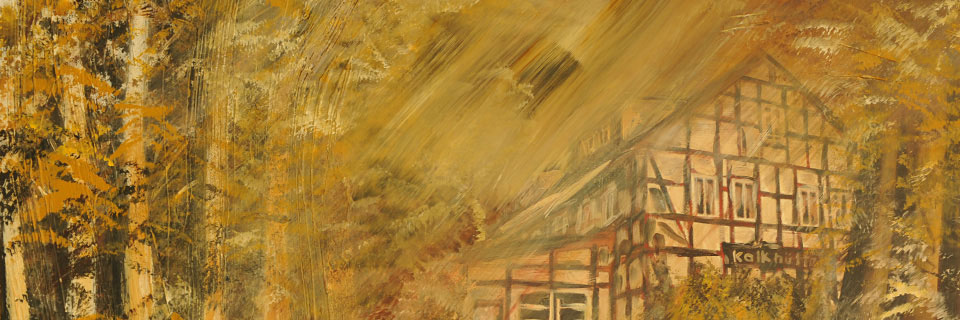An overview of the history of our hotel.
The Kalkhütte - an old Urbach house at no. 177
Today, the “Kalkhütte” is a stylish woodland hotel in a picturesque setting, situated in the “Alter Stolberg”. However, as the name suggests in German, the building was previously used for other purposes. On 3 December 1850, the innkeeper Christian Etzrodt from Urbach applied for permission to the comital Stolberg fiscal chamber “to erect in the valley near Urbach a Kalkhütte”, or limestone kiln building. In the beginning of the year 1851, he renewed his application and was supported in his plans by the local doctor Dr. med. Henze from Urbach. At last, on 12 March 1851, he received a “concession to install a limestone kiln”. One of the first orders, and probably also the largest, was to provide the limestone required for the construction of the church nave in Urbach. This is confirmed by an old document relating to the building: “The limestone was provided by the oxen-drivers, from the limestone mountain, for the limestone was fired there, 578 cartloads in all.” Since Christian Etzrodt was in fact a publican, as mentioned above, the Kalkhütte soon also offered a “place for guests to stop by.” The building soon became a well-known destination for day-trippers.
In 1912, it was purchased by the “Bürgerliches Brauhaus Nordhausen”, a local brewery, which then rented it out in 1921 to private landlords.
In 1929, the then owner, Herr Kallensee, a master painter from Gotha, made great efforts to improve the path. He widened narrow sections and levelled out large areas of the forest path. This made it easier to reach the Kalkhütte with “all types of conveyance.” This factor, together with the charming location, was one of the reasons why the Urbach gymnastics club decided in 1930 to build a gymnastics and sports ground there. Gymnastics, running and handball were the favourite sports in the club. Since 1927, the “MTV Urbach” club had organised one of the local sporting highlights once a year, a cross-country run from the Kalkhütte through the Alter Stolberg and back. The winner was awarded a statue of a walker, while the runners-up were also given prizes. In February 1930, the site was visited and negotiations were held with the Urbach local administration and Roßla comital forest management, who each owned parts of the planned site. An agreement was quickly reached, and the club was granted use of the “land in front of the Kalkhütte” for a symbolic rent of 1 Reichsmark per annum each. On 8 February 1930, work started on the facilities and the necessary earthworks were carried out.
The publican at the Kalkhütte at the time, Herr Krause, contributed to the construction work by paying for 500 working hours, and his wife presented the club with a table banner. On 26 July 1931, the sports grounds were formally opened, and were from then on used for gymnastics training and handball games. A “triathlon for local people from all regions” was held to inaugurate the grounds.
Many parties were held in the Kalkhütte. The oldest photographs show a summer party and the consecration of the flag of the “Waldgemeinschaft Alter Stolberg”, the local forest community society, in August 1932.
In April 1954, the VEB[1] Nortak Hanewacker took over the ownership of the building, and were replaced in 1959 by the VEB Braunkohlenwerk Mücheln, which turned the Kalkhütte into a holiday camp. In 1968, the facility was bought by the VEB Mineralölwerk Lützkendorf, which continued to use the building as a holiday camp until 1990. Thousands of children, young people and adults spent their holidays here during this period.
When the “people-owned enterprises” were dissolved after the fall of the Berlin wall, the Kalkhütte became the property of the Treuhandanstalt privatisation agency. The building was no longer inhabited and, in some parts, was wilfully destroyed and lapsed into disrepair. In 1993, the Urbach local administration purchased the site from the Treuhand and sold it to “Knauf Deutsche Gipswerke KG”, which promised to restore the Kalkhütte to what it had been for more than 100 years, a popular resort for day-trippers.
In 1997, the “Waldhotel Kalkhütte” was opened, and the road leading to it was extended and paved.
Mention should also be made of the Kalkhütte spring, which originates not far from the hotel. However, it only wells up in “wet years” and only flows briefly before disappearing back into the ground.
Urbach, 10 July 2012
Jürgen Vopel
[1] Abbreviation of Volkseigener Betrieb (German: people-owned enterprise). This was the legal form of industrial enterprise in East Germany.










